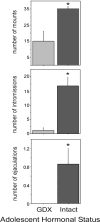The organizing actions of adolescent gonadal steroid hormones on brain and behavioral development
- PMID: 27497718
- PMCID: PMC5074860
- DOI: 10.1016/j.neubiorev.2016.07.036
The organizing actions of adolescent gonadal steroid hormones on brain and behavioral development
Abstract
Adolescence is a developmental period characterized by dramatic changes in cognition, risk-taking and social behavior. Although gonadal steroid hormones are well-known mediators of these behaviors in adulthood, the role gonadal steroid hormones play in shaping the adolescent brain and behavioral development has only come to light in recent years. Here we discuss the sex-specific impact of gonadal steroid hormones on the developing adolescent brain. Indeed, the effects of gonadal steroid hormones during adolescence on brain structure and behavioral outcomes differs markedly between the sexes. Research findings suggest that adolescence, like the perinatal period, is a sensitive period for the sex-specific effects of gonadal steroid hormones on brain and behavioral development. Furthermore, evidence from studies on male sexual behavior suggests that adolescence is part of a protracted postnatal sensitive period that begins perinatally and ends following adolescence. As such, the perinatal and peripubertal periods of brain and behavioral organization likely do not represent two discrete sensitive periods, but instead are the consequence of normative developmental timing of gonadal hormone secretions in males and females.
Keywords: Activational-organizational hypothesis; Adolescence; Agonistic behavior; Anxiety-like behavior; Cortex; Estrogen; Ingestive behavior; Sensitive periods; Sexual behavior; Synaptic pruning; Testosterone.
Copyright © 2016 Elsevier Ltd. All rights reserved.
Figures








Similar articles
-
Back to the future: The organizational-activational hypothesis adapted to puberty and adolescence.Horm Behav. 2009 May;55(5):597-604. doi: 10.1016/j.yhbeh.2009.03.010. Horm Behav. 2009. PMID: 19446076 Free PMC article. Review.
-
Steroid hormones, stress and the adolescent brain: a comparative perspective.Neuroscience. 2013 Sep 26;249:115-28. doi: 10.1016/j.neuroscience.2012.12.016. Epub 2012 Dec 20. Neuroscience. 2013. PMID: 23262238 Review.
-
Endocrine modulation of the adolescent brain: a review.J Pediatr Adolesc Gynecol. 2011 Dec;24(6):330-7. doi: 10.1016/j.jpag.2011.01.061. Epub 2011 Apr 21. J Pediatr Adolesc Gynecol. 2011. PMID: 21514192 Review.
-
Pubertal hormones, the adolescent brain, and the maturation of social behaviors: Lessons from the Syrian hamster.Mol Cell Endocrinol. 2006 Jul 25;254-255:120-6. doi: 10.1016/j.mce.2006.04.025. Epub 2006 Jun 5. Mol Cell Endocrinol. 2006. PMID: 16753257 Review.
-
Comparing Postnatal Development of Gonadal Hormones and Associated Social Behaviors in Rats, Mice, and Humans.Endocrinology. 2018 Jul 1;159(7):2596-2613. doi: 10.1210/en.2018-00220. Endocrinology. 2018. PMID: 29767714 Free PMC article. Review.
Cited by
-
Neuroscience and Sex/Gender: Looking Back and Forward.J Neurosci. 2020 Jan 2;40(1):37-43. doi: 10.1523/JNEUROSCI.0750-19.2019. Epub 2019 Sep 5. J Neurosci. 2020. PMID: 31488609 Free PMC article. Review.
-
Movement Disorders Associated with Hypogonadism.Mov Disord Clin Pract. 2021 Jul 29;8(7):997-1011. doi: 10.1002/mdc3.13308. eCollection 2021 Oct. Mov Disord Clin Pract. 2021. PMID: 34631935 Free PMC article. Review.
-
Timing of peripubertal steroid exposure predicts visuospatial cognition in men: Evidence from three samples.Horm Behav. 2020 May;121:104712. doi: 10.1016/j.yhbeh.2020.104712. Epub 2020 Feb 18. Horm Behav. 2020. PMID: 32059854 Free PMC article.
-
Gonadal Hormone Influences on Sex Differences in Binge Eating Across Development.Curr Psychiatry Rep. 2021 Oct 6;23(11):74. doi: 10.1007/s11920-021-01287-z. Curr Psychiatry Rep. 2021. PMID: 34613500 Free PMC article. Review.
-
Adolescent brain development in girls with Turner syndrome.Hum Brain Mapp. 2023 Jul;44(10):4028-4039. doi: 10.1002/hbm.26327. Epub 2023 May 1. Hum Brain Mapp. 2023. PMID: 37126641 Free PMC article.
References
-
- Adkins-Regan E, Orgeur P, Signoret JP. Sexual differentiation of reproductive behavior in pigs: defeminizing effects of prepubertal estradiol. Horm Behav. 1989;23:290–303. - PubMed
-
- Andersen SL. Trajectories of brain development: point of vulnerability or window of opportunity? Neurosci Biobehav Rev. 2003;27:3–18. - PubMed
-
- Andersen SL, Rutstein M, Benzo JM, Hostetter JC, Teicher MH. Sex differences in dopamine receptor overproduction and elimination. Neuroreport. 1997;8:1495–1498. - PubMed
-
- Andrews WW, Mizejewski GJ, Ojeda SR. Development of estradiol-positive feedback on luteinizing hormone release in the female rat: a quantitative study. Endocrinology. 1981;109:1404–1413. - PubMed
Publication types
MeSH terms
Substances
Grants and funding
LinkOut - more resources
Full Text Sources
Other Literature Sources
Medical
Research Materials

